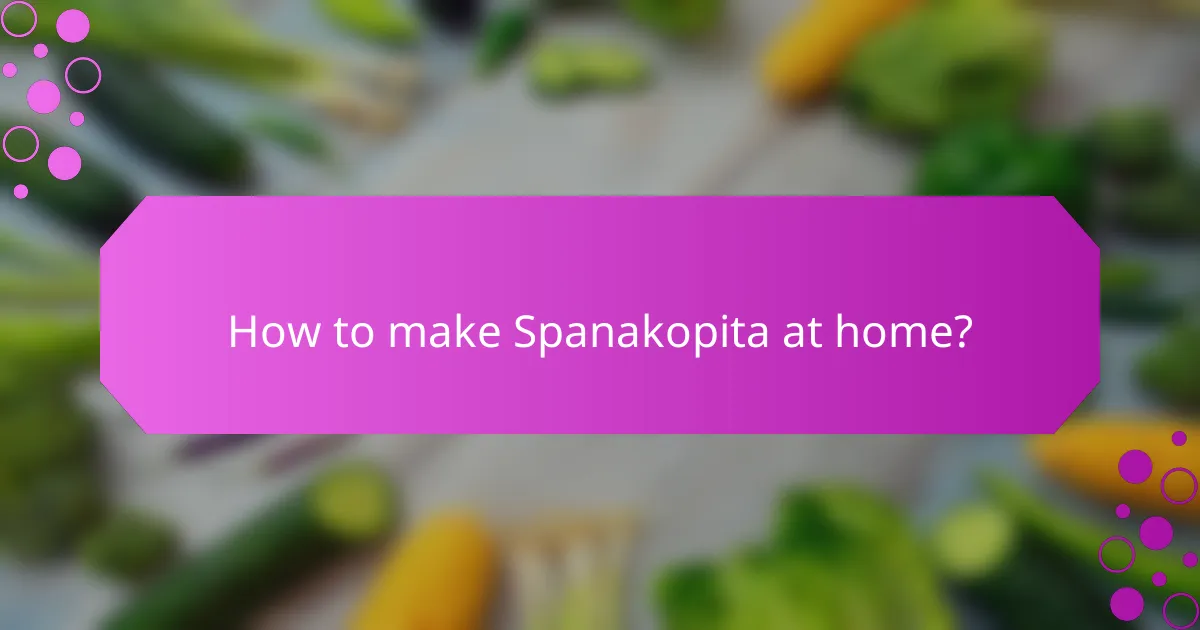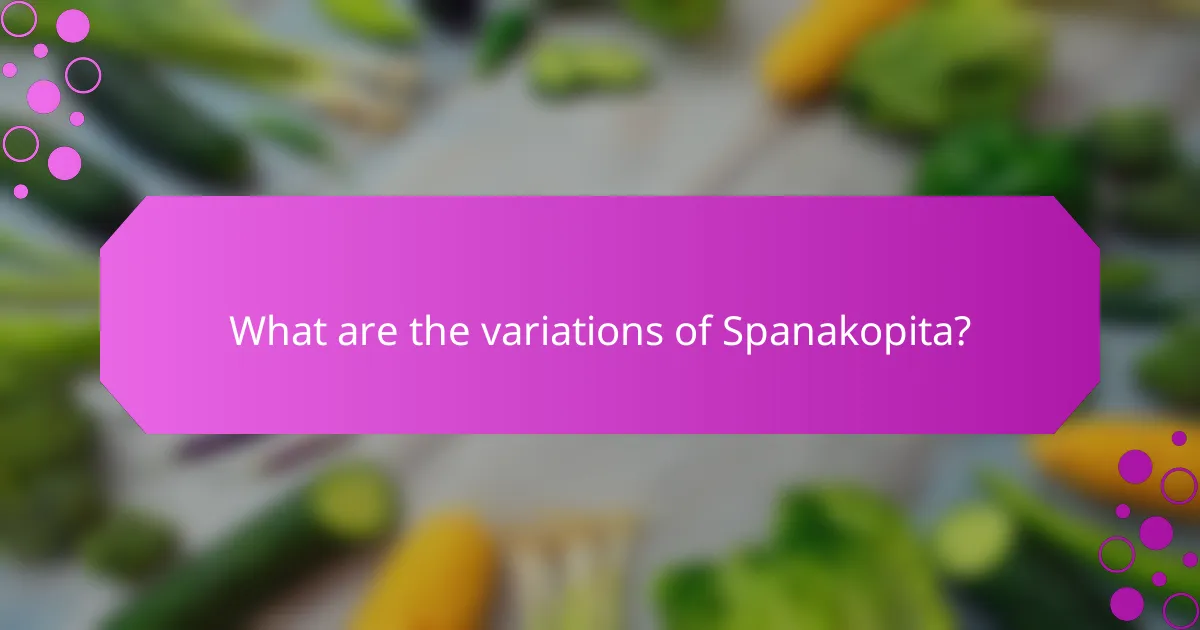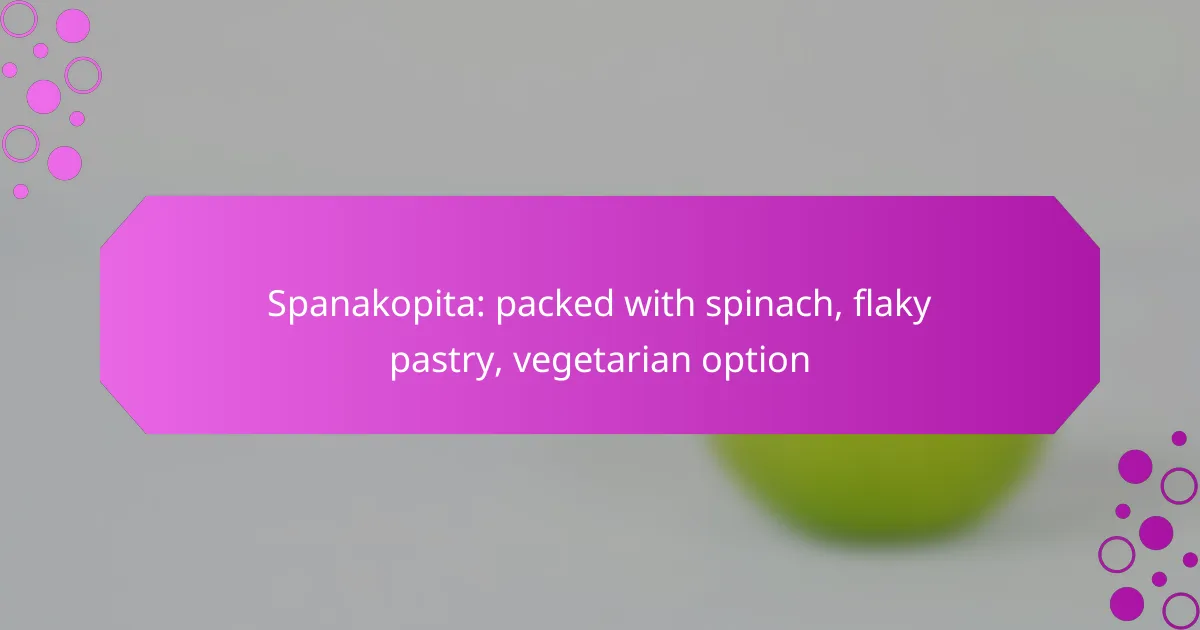Spanakopita is a delightful Greek dish that features layers of flaky phyllo pastry filled with a savory mixture of spinach and feta cheese. This vegetarian option is not only delicious but also packed with nutrients, making it a healthy choice for any meal. Perfect as an appetizer or a main course, Spanakopita brings a taste of Mediterranean cuisine to your table.

How to make Spanakopita at home?
Making Spanakopita at home involves layering flaky pastry with a savory filling of spinach and feta cheese. This traditional Greek dish is not only delicious but also a satisfying vegetarian option that can be enjoyed as an appetizer or main course.
Ingredients list for homemade Spanakopita
To prepare Spanakopita, you will need the following ingredients:
- 1 package of phyllo pastry (approximately 16 oz)
- 500 grams of fresh spinach or 300 grams of frozen spinach
- 200 grams of feta cheese, crumbled
- 1 medium onion, finely chopped
- 2-3 tablespoons of olive oil
- 2 eggs, beaten
- Salt and pepper to taste
- Fresh dill or parsley (optional)
Ensure you have all ingredients ready before starting, as working with phyllo pastry requires quick handling to prevent it from drying out.
Step-by-step cooking instructions
Begin by preheating your oven to 180°C (350°F). If using fresh spinach, wash and chop it; if using frozen, thaw and drain it well. In a pan, heat olive oil and sauté the onion until translucent, then add the spinach and cook until wilted. Remove from heat and let it cool.
In a mixing bowl, combine the cooled spinach mixture with crumbled feta, beaten eggs, salt, pepper, and herbs if using. Lay out a sheet of phyllo pastry, brush it lightly with olive oil, and layer another sheet on top. Place a portion of the filling along one edge and roll it up tightly. Shape the roll into a spiral or place it in a baking dish.
Bake for about 30-40 minutes or until golden brown. Allow it to cool slightly before serving.
Recommended cooking tools
To make Spanakopita efficiently, consider using the following tools:
- A large mixing bowl for combining ingredients
- A sauté pan for cooking the filling
- A pastry brush for applying oil to the phyllo
- A sharp knife or pizza cutter for cutting the pastry
- A baking dish or sheet for baking
Having these tools on hand will streamline the preparation process and help achieve the best results with your Spanakopita.

Where to buy the best Spanakopita ingredients?
To create delicious Spanakopita, sourcing high-quality ingredients is essential. Look for fresh spinach, feta cheese, and flaky phyllo pastry, which can be found at various local and online retailers.
Local grocery stores in the US
Many local grocery stores in the US carry the necessary ingredients for Spanakopita. Chains like Whole Foods, Trader Joe’s, and Safeway typically stock fresh spinach, various cheeses, and phyllo dough in their frozen sections.
When shopping, check the produce section for fresh spinach and herbs, as well as the dairy aisle for feta cheese. It’s advisable to visit stores with a good selection of international foods, as they may offer specialty products that enhance your Spanakopita.
Online retailers for Spanakopita supplies
Online shopping is a convenient option for purchasing Spanakopita ingredients. Websites like Amazon, Walmart, and specialty food sites often offer a range of products, including frozen phyllo dough and imported feta cheese.
When ordering online, consider checking for bulk options or subscription services that can save you money over time. Ensure that the retailer provides proper shipping methods to maintain the quality of perishable items like cheese and fresh greens.

What are the health benefits of Spanakopita?
Spanakopita offers several health benefits, primarily due to its key ingredient, spinach, which is rich in nutrients. This dish provides a good source of vitamins, minerals, and antioxidants while being a delicious vegetarian option.
Nutritional value of spinach
Spinach is a powerhouse of nutrition, containing high levels of vitamins A, C, and K, as well as folate and iron. A typical serving can provide significant portions of daily recommended values for these nutrients, contributing to overall health.
Additionally, spinach is low in calories, making it an excellent choice for those looking to maintain or lose weight. Its high fiber content also aids in digestion and promotes a feeling of fullness.
Vegetarian protein sources in Spanakopita
While spinach is not a significant source of protein, Spanakopita includes other ingredients that contribute to its protein content. Feta cheese, often used in the filling, provides a good amount of protein and calcium, enhancing the dish’s nutritional profile.
To further boost protein levels, consider adding ingredients like chickpeas or lentils to the filling. These legumes are excellent vegetarian protein sources and can complement the flavors of spinach and cheese in Spanakopita.

How to serve Spanakopita for gatherings?
Serving Spanakopita at gatherings is a delightful way to offer guests a tasty vegetarian option. This flaky pastry filled with spinach and feta can be enjoyed warm or at room temperature, making it versatile for various occasions.
Best side dishes to pair with Spanakopita
Spanakopita pairs well with a variety of side dishes that complement its flavors. Consider serving it alongside a fresh Greek salad, which adds a refreshing crunch with tomatoes, cucumbers, and olives. Tzatziki sauce is another excellent choice, providing a cool, creamy contrast to the savory pastry.
For a heartier meal, roasted vegetables or a quinoa salad can round out the plate. These sides not only enhance the meal but also add nutritional value, making your gathering more satisfying.
Serving suggestions for parties
When serving Spanakopita at parties, consider cutting the pastries into bite-sized pieces for easy handling. Arrange them on a large platter, garnished with lemon wedges and fresh herbs to enhance presentation. This approach encourages guests to sample and enjoy the dish without the need for utensils.
Additionally, offering a variety of dips, such as hummus or baba ganoush, can elevate the experience. Make sure to keep the Spanakopita warm in a chafing dish or serve it fresh from the oven to maintain its flaky texture.

What are the variations of Spanakopita?
Spanakopita, a traditional Greek pastry, has numerous variations that highlight different fillings and regional styles. While spinach and feta cheese are the most common ingredients, many recipes incorporate other vegetables, herbs, and cheeses to create unique flavors.
Different fillings for Spanakopita
The classic filling for Spanakopita consists of spinach and feta cheese, but variations can include ingredients like ricotta, leeks, or even herbs such as dill and parsley. Some recipes may substitute spinach with other greens like Swiss chard or kale, offering a different taste and nutritional profile.
Vegetarians can enjoy Spanakopita with fillings that include mushrooms, artichokes, or roasted peppers, providing a hearty alternative. When experimenting with fillings, consider balancing flavors and textures to maintain the flaky pastry’s integrity.
Regional variations of Spanakopita
Spanakopita varies significantly across Greece and neighboring countries, reflecting local tastes and available ingredients. In Crete, for example, you might find a version that incorporates local cheeses and wild greens, while in mainland Greece, the focus remains on spinach and feta.
In Turkey, a similar dish called “Börek” often features different types of fillings, including minced meat or potatoes, and is made with a different type of dough. These regional adaptations showcase the versatility of Spanakopita and its ability to blend with local culinary traditions.

How to store and reheat Spanakopita?
To store and reheat Spanakopita effectively, keep it in an airtight container in the refrigerator for up to a week or freeze it for longer preservation. Reheating can be done in the oven or microwave, with the oven providing the best texture.
Best storage practices
For short-term storage, place leftover Spanakopita in an airtight container and refrigerate it. This will keep it fresh for about 5 to 7 days. If you want to store it for a longer period, wrap individual pieces in plastic wrap or aluminum foil and place them in a freezer-safe bag or container, where they can last for several months.
When freezing, label the container with the date to track freshness. Avoid stacking the pieces directly on top of each other to prevent sticking. Instead, freeze them on a baking sheet first, then transfer them to a bag once solid.
Reheating methods for optimal taste
The best way to reheat Spanakopita is in the oven. Preheat the oven to around 350°F (175°C), place the Spanakopita on a baking sheet, and heat for about 15 to 20 minutes until crispy and heated through. This method helps maintain the flaky texture of the pastry.
If you’re short on time, you can use a microwave, but be aware that this may result in a softer crust. Heat on medium power for 1 to 2 minutes, checking frequently to avoid overcooking. For a quick fix, consider using an air fryer, which can reheat Spanakopita in about 5 to 7 minutes while keeping it crisp.

What are the trends in vegetarian pastries?
Vegetarian pastries are increasingly popular, driven by a growing demand for plant-based options. Consumers are seeking flavorful, nutritious alternatives that cater to dietary preferences while still delivering on taste and texture.
Emerging flavors in vegetarian options
Innovative flavors are transforming vegetarian pastries, moving beyond traditional fillings. Ingredients like feta, sun-dried tomatoes, and various herbs are being combined with classic vegetables such as spinach and mushrooms to create unique taste profiles.
Additionally, international influences are shaping these offerings. For instance, Middle Eastern spices like za’atar and harissa are being incorporated, adding depth and excitement to vegetarian pastries.
Innovative pastry techniques
Modern pastry techniques are enhancing the quality and appeal of vegetarian pastries. Techniques such as lamination, which creates flaky layers, are being applied to plant-based doughs, resulting in a satisfying texture.
Chefs are also experimenting with alternative flours, such as chickpea or spelt, to cater to gluten-free diets while maintaining flavor and structure. This approach not only diversifies the options available but also meets the needs of health-conscious consumers.
